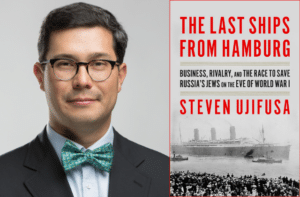The Ships That Carried Them to America
October 10, 2024 in Library Corner
By Robin Jacobson.

It’s the stuff of family lore and American history. In the late 19th and early 20th centuries, over 10 million European immigrants crossed the Atlantic Ocean to America. These included 2.5 million Jews, many of them fleeing pogroms, persecution, and poverty in the Czarist Russian Empire. Courageous and determined, they built new lives in the United States.
But this epic tale of immigration rarely mentions an essential element – the extraordinary innovations in the shipping industry that made the immigrants’ journey possible. Maritime historian Steven Ujifusa fills in this little-told part of the immigrant story in The Last Ships from Hamburg: Business, Rivalry, and the Race to Save Russia’s Jews on the Eve of World War I.
Last Ships is a group portrait of three business titans – Albert Ballin, Jacob Schiff, and J.P. Morgan – who profoundly affected American immigration. However, it is the German Jewish shipping magnate, Ballin (1857-1918), who dominates the book. Thousands of immigrants came to America on ships designed and run by Ballin (nicknamed the “King of Steerage”).
From the Russian Empire to Hamburg
As Ujifusa recounts, Jewish desperation to leave the Russian Empire in the waning years of the 19th century fortuitously coincided with the development of new technology – giant steel steamships – capable of swiftly ferrying huge numbers of immigrants from Europe to America. What’s more, America welcomed immigrants. Between 1881 and 1914, the United States had a largely unrestricted immigration policy. American business wanted cheap labor, and new immigrants were eager to work.
In the 1840s, poor European immigrants to America arrived on wooden sailing ships after a long journey of one-to-two months cramped below deck in miserable conditions. But as the century progressed, transatlantic travel became faster, safer, and more widely available. Steamships could cross the ocean in a mere one-to-two weeks, and some could accommodate over 2,000 steerage passengers at a time.
Even so, Jewish emigrants from the Russian Empire faced an arduous, dangerous journey to reach the European seaports from which ships for America departed. One daunting obstacle was the Russian Empire’s restrictions on Jewish movement; this meant that most emigrants had to illegally cross one or more borders just to exit the Empire. Fortunately, there was a shipping tycoon ready to help.
Albert Ballin
Born in Hamburg to a poor Jewish family, Albert Ballin rose to become the managing director of the German Hamburg-American Line. Under Ballin’s leadership, this shipping company became the world’s largest by expanding its emigration business.
Ballin increased steerage capacity in both new and existing ships. Equally important, he facilitated the entire emigrant journey. Ballin’s agents helped smuggle emigrants out of Russia. They also staffed Russian-Prussian border crossing stations where they assisted emigrants with train travel to the port city of Hamburg.
Ballin persuaded the Hamburg Senate to allow an unlimited number of emigrants to stay in Hamburg while waiting for their steamships to America. He promised to contain the emigrants within a self-sufficient village built by his company. This calmed Hamburg’s fears about emigrants spreading disease. At the same time, the village ensured that emigrants had food and housing.
Ballin was not an altruist; he and his company profited immensely from transporting emigrants. Yet the emigrants, too, benefitted from Ballin’s efforts to ease their journey across Europe and to provide better food and service onboard ship than his competitors, even if he did so in the hope that satisfied customers would encourage others to book passage.
Kaiser Wilhelm II admired and honored Ballin for his expansion of Germany’s maritime industry. But when the Nazis gained power, they tried to erase Ballin’s legacy, even repurposing his emigrant village as a prison camp. Today, however, the site houses an Immigration Museum that restores Albert Ballin to his earned place in history.